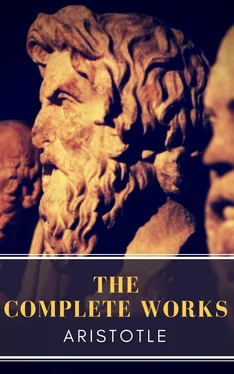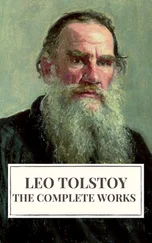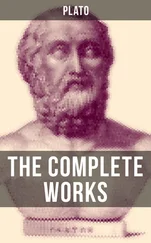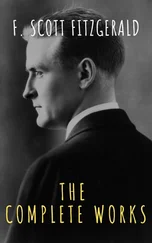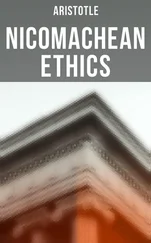Aristotle Aristotle - Aristotle - The Complete Works
Здесь есть возможность читать онлайн «Aristotle Aristotle - Aristotle - The Complete Works» — ознакомительный отрывок электронной книги совершенно бесплатно, а после прочтения отрывка купить полную версию. В некоторых случаях можно слушать аудио, скачать через торрент в формате fb2 и присутствует краткое содержание. Жанр: unrecognised, на английском языке. Описание произведения, (предисловие) а так же отзывы посетителей доступны на портале библиотеки ЛибКат.
- Название:Aristotle: The Complete Works
- Автор:
- Жанр:
- Год:неизвестен
- ISBN:нет данных
- Рейтинг книги:3 / 5. Голосов: 1
-
Избранное:Добавить в избранное
- Отзывы:
-
Ваша оценка:
- 60
- 1
- 2
- 3
- 4
- 5
Aristotle: The Complete Works: краткое содержание, описание и аннотация
Предлагаем к чтению аннотацию, описание, краткое содержание или предисловие (зависит от того, что написал сам автор книги «Aristotle: The Complete Works»). Если вы не нашли необходимую информацию о книге — напишите в комментариях, мы постараемся отыскать её.
This edition has been professionally formatted and contains several tables of contents. The first table of contents (at the very beginning of the ebook) lists the titles of all novels included in this volume. By clicking on one of those titles you will be redirected to the beginning of that work, where you'll find a new TOC that lists all the chapters and sub-chapters of that specific work.
Aristotle: The Complete Works — читать онлайн ознакомительный отрывок
Ниже представлен текст книги, разбитый по страницам. Система сохранения места последней прочитанной страницы, позволяет с удобством читать онлайн бесплатно книгу «Aristotle: The Complete Works», без необходимости каждый раз заново искать на чём Вы остановились. Поставьте закладку, и сможете в любой момент перейти на страницу, на которой закончили чтение.
Интервал:
Закладка:
(1) If it is E the syllogism will have A and B for its sole premisses. But if C and D are so related that one is whole, the other part, some conclusion will follow from them also; and it must be either E, or one or other of the propositions A and B, or something other than these. And if it is (i) E, or (ii) A or B, either (i) the syllogisms will be more than one, or (ii) the same thing happens to be inferred by means of several terms only in the sense which we saw to be possible. But if (iii) the conclusion is other than E or A or B, the syllogisms will be many, and unconnected with one another. But if C is not so related to D as to make a syllogism, the propositions will have been assumed to no purpose, unless for the sake of induction or of obscuring the argument or something of the sort.
(2) But if from the propositions A and B there follows not E but some other conclusion, and if from C and D either A or B follows or something else, then there are several syllogisms, and they do not establish the conclusion proposed: for we assumed that the syllogism proved E. And if no conclusion follows from C and D, it turns out that these propositions have been assumed to no purpose, and the syllogism does not prove the original proposition.
So it is clear that every demonstration and every syllogism will proceed through three terms only.
This being evident, it is clear that a syllogistic conclusion follows from two premisses and not from more than two. For the three terms make two premisses, unless a new premiss is assumed, as was said at the beginning, to perfect the syllogisms. It is clear therefore that in whatever syllogistic argument the premisses through which the main conclusion follows (for some of the preceding conclusions must be premisses) are not even in number, this argument either has not been drawn syllogistically or it has assumed more than was necessary to establish its thesis.
If then syllogisms are taken with respect to their main premisses, every syllogism will consist of an even number of premisses and an odd number of terms (for the terms exceed the premisses by one), and the conclusions will be half the number of the premisses. But whenever a conclusion is reached by means of prosyllogisms or by means of several continuous middle terms, e.g. the proposition AB by means of the middle terms C and D, the number of the terms will similarly exceed that of the premisses by one (for the extra term must either be added outside or inserted: but in either case it follows that the relations of predication are one fewer than the terms related), and the premisses will be equal in number to the relations of predication. The premisses however will not always be even, the terms odd; but they will alternate-when the premisses are even, the terms must be odd; when the terms are even, the premisses must be odd: for along with one term one premiss is added, if a term is added from any quarter. Consequently since the premisses were (as we saw) even, and the terms odd, we must make them alternately even and odd at each addition. But the conclusions will not follow the same arrangement either in respect to the terms or to the premisses. For if one term is added, conclusions will be added less by one than the pre-existing terms: for the conclusion is drawn not in relation to the single term last added, but in relation to all the rest, e.g. if to ABC the term D is added, two conclusions are thereby added, one in relation to A, the other in relation to B. Similarly with any further additions. And similarly too if the term is inserted in the middle: for in relation to one term only, a syllogism will not be constructed. Consequently the conclusions will be much more numerous than the terms or the premisses.
26
Since we understand the subjects with which syllogisms are concerned, what sort of conclusion is established in each figure, and in how many moods this is done, it is evident to us both what sort of problem is difficult and what sort is easy to prove. For that which is concluded in many figures and through many moods is easier; that which is concluded in few figures and through few moods is more difficult to attempt. The universal affirmative is proved by means of the first figure only and by this in only one mood; the universal negative is proved both through the first figure and through the second, through the first in one mood, through the second in two. The particular affirmative is proved through the first and through the last figure, in one mood through the first, in three moods through the last. The particular negative is proved in all the figures, but once in the first, in two moods in the second, in three moods in the third. It is clear then that the universal affirmative is most difficult to establish, most easy to overthrow. In general, universals are easier game for the destroyer than particulars: for whether the predicate belongs to none or not to some, they are destroyed: and the particular negative is proved in all the figures, the universal negative in two. Similarly with universal negatives: the original statement is destroyed, whether the predicate belongs to all or to some: and this we found possible in two figures. But particular statements can be refuted in one way only-by proving that the predicate belongs either to all or to none. But particular statements are easier to establish: for proof is possible in more figures and through more moods. And in general we must not forget that it is possible to refute statements by means of one another, I mean, universal statements by means of particular, and particular statements by means of universal: but it is not possible to establish universal statements by means of particular, though it is possible to establish particular statements by means of universal. At the same time it is evident that it is easier to refute than to establish.
The manner in which every syllogism is produced, the number of the terms and premisses through which it proceeds, the relation of the premisses to one another, the character of the problem proved in each figure, and the number of the figures appropriate to each problem, all these matters are clear from what has been said.
27
We must now state how we may ourselves always have a supply of syllogisms in reference to the problem proposed and by what road we may reach the principles relative to the problem: for perhaps we ought not only to investigate the construction of syllogisms, but also to have the power of making them.
Of all the things which exist some are such that they cannot be predicated of anything else truly and universally, e.g. Cleon and Callias, i.e. the individual and sensible, but other things may be predicated of them (for each of these is both man and animal); and some things are themselves predicated of others, but nothing prior is predicated of them; and some are predicated of others, and yet others of them, e.g. man of Callias and animal of man. It is clear then that some things are naturally not stated of anything: for as a rule each sensible thing is such that it cannot be predicated of anything, save incidentally: for we sometimes say that that white object is Socrates, or that that which approaches is Callias. We shall explain in another place that there is an upward limit also to the process of predicating: for the present we must assume this. Of these ultimate predicates it is not possible to demonstrate another predicate, save as a matter of opinion, but these may be predicated of other things. Neither can individuals be predicated of other things, though other things can be predicated of them. Whatever lies between these limits can be spoken of in both ways: they may be stated of others, and others stated of them. And as a rule arguments and inquiries are concerned with these things. We must select the premisses suitable to each problem in this manner: first we must lay down the subject and the definitions and the properties of the thing; next we must lay down those attributes which follow the thing, and again those which the thing follows, and those which cannot belong to it. But those to which it cannot belong need not be selected, because the negative statement implied above is convertible. Of the attributes which follow we must distinguish those which fall within the definition, those which are predicated as properties, and those which are predicated as accidents, and of the latter those which apparently and those which really belong. The larger the supply a man has of these, the more quickly will he reach a conclusion; and in proportion as he apprehends those which are truer, the more cogently will he demonstrate. But he must select not those which follow some particular but those which follow the thing as a whole, e.g. not what follows a particular man but what follows every man: for the syllogism proceeds through universal premisses. If the statement is indefinite, it is uncertain whether the premiss is universal, but if the statement is definite, the matter is clear. Similarly one must select those attributes which the subject follows as wholes, for the reason given. But that which follows one must not suppose to follow as a whole, e.g. that every animal follows man or every science music, but only that it follows, without qualification, and indeed we state it in a proposition: for the other statement is useless and impossible, e.g. that every man is every animal or justice is all good. But that which something follows receives the mark ‘every’. Whenever the subject, for which we must obtain the attributes that follow, is contained by something else, what follows or does not follow the highest term universally must not be selected in dealing with the subordinate term (for these attributes have been taken in dealing with the superior term; for what follows animal also follows man, and what does not belong to animal does not belong to man); but we must choose those attributes which are peculiar to each subject. For some things are peculiar to the species as distinct from the genus; for species being distinct there must be attributes peculiar to each. Nor must we take as things which the superior term follows, those things which the inferior term follows, e.g. take as subjects of the predicate ‘animal’ what are really subjects of the predicate ‘man’. It is necessary indeed, if animal follows man, that it should follow all these also. But these belong more properly to the choice of what concerns man. One must apprehend also normal consequents and normal antecedents-, for propositions which obtain normally are established syllogistically from premisses which obtain normally, some if not all of them having this character of normality. For the conclusion of each syllogism resembles its principles. We must not however choose attributes which are consequent upon all the terms: for no syllogism can be made out of such premisses. The reason why this is so will be clear in the sequel.
Читать дальшеИнтервал:
Закладка:
Похожие книги на «Aristotle: The Complete Works»
Представляем Вашему вниманию похожие книги на «Aristotle: The Complete Works» списком для выбора. Мы отобрали схожую по названию и смыслу литературу в надежде предоставить читателям больше вариантов отыскать новые, интересные, ещё непрочитанные произведения.
Обсуждение, отзывы о книге «Aristotle: The Complete Works» и просто собственные мнения читателей. Оставьте ваши комментарии, напишите, что Вы думаете о произведении, его смысле или главных героях. Укажите что конкретно понравилось, а что нет, и почему Вы так считаете.
